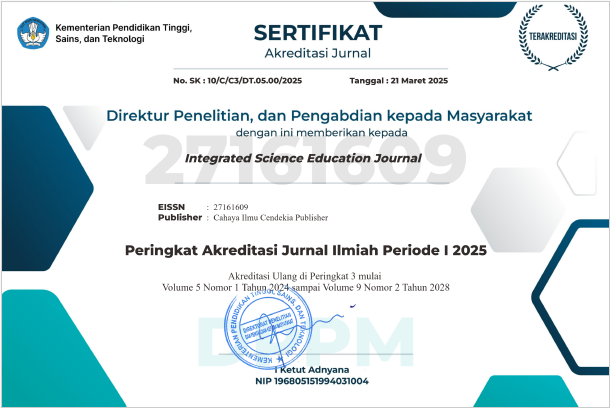Wearable Energy Harvester: Application of Piezoelectric Sensors in Shoes as a Portable Power Source
Abstract
Purpose of the study: This study aims to analyze the effect of variations in pressure loading on piezoelectric sensors mounted on shoes on the amount of electrical power generated and to compare the performance of series and parallel circuit configurations in real-time energy harvesting applications.
Methodology: This study used an experimental method with a ceramic piezoelectric sensor (2 cm diameter), a digital multimeter, a shoe insole, a 100 µF 25 V capacitor, a 1N4002 diode, connecting cables, and a soldering tool. Data were collected with variations in body weight (52.65 kg–72.65 kg) and gait speed (normal walking, fast walking, running) for 2 km for series and parallel configurations.
Main Findings: The results showed that the greater the pressure due to body weight, the higher the electrical power generated. The series circuit produced a maximum power of 3.39 µW, while the parallel circuit reached 51.2 µW at varying weights. At varying speeds, running produced the highest power, with a maximum of 42.56 mW in the parallel configuration. This demonstrates that circuit configuration and pressure significantly influence power output.
Novelty/Originality of this study: This research presents a wearable prototype that integrates piezoelectric sensors, shoe design, and a power storage system for real-time energy harvesting. Unlike previous research limited to simulations, this study demonstrates a functional prototype capable of charging low-power devices, thus supporting sustainable energy technologies and developing the application of piezoelectric principles to portable energy sources.
References
A. Riaz, M. R. Sarker, M. H. M. Saad, and R. Mohamed, “Review on comparison of different energy storage technologies used in micro-energy harvesting, wsns, low-cost microelectronic devices: Challenges and recommendations,” Sensors, vol. 21, no. 15, pp. 1–33, 2021, doi: 10.3390/s21155041.
M. A. H. Aman, N. Shaari, and R. Ibrahim, “Internet of things energy system: Smart applications, technology advancement, and open issues,” Int. J. Energy Res., vol. 45, no. 6, pp. 8389–8419, May 2021, doi: 10.1002/er.6451.
S. T. Ghulam and H. Abushammala, “Challenges and opportunities in the management of electronic waste and its impact on human health and environment,” Sustain., vol. 15, no. 3, pp. 1–22, 2023, doi: 10.3390/su15031837.
I. Moraiti, “Examining the stress level of autistic people using a smartwatch integrated with the internet of things technology,” World J. Adv. Res. Rev., vol. 19, no. 2, pp. 1372–1389, 2023, doi: 10.30574/wjarr.2023.19.2.1743.
M. M. Hosseini, S. T. M. Hosseini, K. Qayumi, S. Hosseinzadeh, and S. S. S. Tabar, “Smartwatches in healthcare medicine: Assistance and monitoring; a scoping review,” BMC Med. Inform. Decis. Mak., vol. 23, no. 1, pp. 1–26, 2023, doi: 10.1186/s12911-023-02350-w.
S. Shahzad, M. A. Abbasi, H. Ali, M. Iqbal, R. Munir, and H. Kilic, “Possibilities, challenges, and future opportunities of microgrids: A Review,” Sustain., vol. 15, no. 8, pp. 1–28, 2023, doi: 10.3390/su15086366.
G. G. Njema, R. B. O. Ouma, and J. K. Kibet, “A review on the recent advances in battery development and energy storage technologies,” J. Renew. Energy, vol. 2024, pp. 1–35, May 2024, doi: 10.1155/2024/2329261.
K. A. Chandra, S. Narayan, K. A. Mamun, A. A. Chand, D. Prasad, and M. R. Ahmed, “A review of footstep energy harvesting systems,” IEEE Access, vol. 13, no. April, pp. 87149–87174, 2025, doi: 10.1109/ACCESS.2025.3570963.
S. A. I. Zaidi, S. Iqbal, F. Hussain, M. H. Ikram, W. Javid, and M. Mateen, “A novel low-cost mechanism for energy generation through footsteps,” Mater. Today Proc., vol. 17, no. 18, pp. 1–6, 2024, doi: 10.3390/materproc2024017018.
D. Yeboah, S. Abaidoo Quainoo, and A. W. Brew, “Hybrid electricity generation using solar energy and kinetic energy of players’ footsteps–a case study: Tarkwa Akoon soccer park, Ghana,” Int. J. Ambient Energy, vol. 44, no. 1, pp. 2347–2361, 2023, doi: 10.1080/01430750.2023.2235342.
H. Afshar, F. Kamran, and F. Shahi, “Recent Progress in Energy Harvesting Technologies for Self‐Powered Wearable Devices: The Significance of Polymers,” Polym. Adv. Technol., vol. 36, no. 4, Apr. 2025, doi: 10.1002/pat.70187.
Y. Li, Z. Sun, M. Huang, L. Sun, H. Liu, and C. Lee, “Self‐Sustained artificial internet of things based on vibration energy harvesting technology: Toward the future Eco‐Society,” Adv. Energy Sustain. Res., vol. 5, no. 11, Nov. 2024, doi: 10.1002/aesr.202400116.
H. Bamoumen, H. El Hafdaoui, and A. Khallaayoun, “Feasibility study of a piezoelectric footstep power generator for smart university campus,” Proc. 2024 1st Ed. Mediterr. Smart Cities Conf. MSCC 2024, no. October, 2024, doi: 10.1109/MSCC62288.2024.10697059.
S. Roy, A. N. M. Wasekul Azad, S. Baidya, M. K. Alam, and F. Khan, “Powering Solutions for Biomedical Sensors and Implants Inside the Human Body: A Comprehensive Review on Energy Harvesting Units, Energy Storage, and Wireless Power Transfer Techniques,” IEEE Trans. Power Electron., vol. 37, no. 10, pp. 12237–12263, 2022, doi: 10.1109/TPEL.2022.3164890.
T. Sanislav, G. D. Mois, S. Zeadally, and S. C. Folea, “Energy harvesting techniques for internet of things (IoT),” IEEE Access, vol. 9, pp. 39530–39549, 2021, doi: 10.1109/ACCESS.2021.3064066.
R. De Fazio, M. De Giorgi, D. Cafagna, C. Del-Valle-Soto, and P. Visconti, “Energy harvesting technologies and devices from vehicular transit and natural sources on roads for a sustainable transport: State-of-the-Art analysis and commercial solutions,” Energies, vol. 16, no. 7, pp. 1–46, 2023, doi: 10.3390/en16073016.
T. Li and P. S. Lee, “Piezoelectric energy harvesting technology: From materials, structures, to applications,” Small Struct., vol. 3, no. 3, pp. 1–17, 2022, doi: 10.1002/sstr.202100128.
G. Clementi et al., “Review on innovative piezoelectric materials for mechanical energy harvesting,” 2022. doi: 10.3390/en15176227.
I. A. Parinov and A. V. Cherpakov, “Overview: State-of-the-art in the energy harvesting based on piezoelectric devices for last decade,” Symmetry (Basel)., vol. 14, no. 4, pp. 1–49, 2022, doi: 10.3390/sym14040765.
M. Ju et al., “Piezoelectric materials and sensors for structural health monitoring: Fundamental aspects, current status, and future perspectives,” Sensors, vol. 23, no. 1, pp. 1–20, 2023, doi: 10.3390/s23010543.
C. Zhi, S. Shi, Y. Si, B. Fei, H. Huang, and J. Hu, “Recent progress of wearable piezoelectric pressure sensors based on nanofibers, yarns, and their fabrics via electrospinning,” Adv. Mater. Technol., vol. 8, no. 5, Mar. 2023, doi: 10.1002/admt.202201161.
M. Habib, I. Lantgios, and K. Hornbostel, “A review of ceramic, polymer and composite piezoelectric materials,” J. Phys. D. Appl. Phys., vol. 55, no. 42, pp. 1–20, 2022, doi: 10.1088/1361-6463/ac8687.
Y. Liao et al., “A review of flexible acceleration sensors based on piezoelectric materials: Performance characterization, parametric analysis, frontier technologies, and applications,” Coatings, vol. 13, no. 7, pp. 1–28, 2023, doi: 10.3390/coatings13071252.
W. Sikorski and A. Wielewski, “Low-Cost online partial discharge monitoring system for power transformers,” Sensors, vol. 23, no. 7, pp. 1–21, 2023, doi: 10.3390/s23073405.
A. Roszkiewicz, M. Garlińska, and A. Pregowska, “Advancements in Piezoelectric‐Enabled Devices for Optical Communication,” Phys. status solidi, vol. 222, no. 2, Jan. 2025, doi: 10.1002/pssa.202400298.
Y. Cao, J. Li, A. Sha, Z. Liu, F. Zhang, and X. Li, “A power-intensive piezoelectric energy harvester with efficient load utilization for road energy collection: Design, testing, and application,” J. Clean. Prod., vol. 369, p. 133287, Oct. 2022, doi: 10.1016/j.jclepro.2022.133287.
G. Sebald et al., “Piezoelectric small scale generator: towards near-Joule output energy generation,” Smart Mater. Struct., vol. 32, no. 8, pp. 1–13, 2023, doi: 10.1088/1361-665X/acdf31.
G. Rong, Y. Zheng, and M. Sawan, “Energy solutions for wearable sensors: A review,” Sensors, vol. 21, no. 11, pp. 1–23, 2021, doi: 10.3390/s21113806.
A. E. Alattar and S. Mohsen, “A survey on smart wearable devices for healthcare applications,” Wirel. Pers. Commun., vol. 132, no. 1, pp. 775–783, 2023, doi: 10.1007/s11277-023-10639-2.
J. Lv, J. Chen, and P. S. Lee, “Sustainable wearable energy storage devices self‐charged by human‐body bioenergy,” SusMat, vol. 1, no. 2, pp. 285–302, Jun. 2021, doi: 10.1002/sus2.14.
Y. Wang, P. Zang, D. Yang, R. Zhang, S. Gai, and P. Yang, “The fundamentals and applications of piezoelectric materials for tumor therapy: recent advances and outlook,” Mater. Horizons, vol. 10, no. 4, pp. 1140–1184, 2023, doi: 10.1039/D2MH01221A.
X. Cao, Y. Xiong, J. Sun, X. Zhu, Q. Sun, and Z. L. Wang, “Piezoelectric nanogenerators derived self‐powered sensors for multifunctional applications and artificial intelligence,” Adv. Funct. Mater., vol. 31, no. 33, Aug. 2021, doi: 10.1002/adfm.202102983.
M. Iqbal, F. U. Khan, M. Mehdi, Q. Cheok, E. Abas, and M. M. Nauman, “Power harvesting footwear based on piezo-electromagnetic hybrid generator for sustainable wearable microelectronics,” J. King Saud Univ. - Eng. Sci., vol. 34, no. 5, pp. 329–338, 2022, doi: 10.1016/j.jksues.2020.11.003.
B. Zhao, F. Qian, A. Hatfield, L. Zuo, and T. B. Xu, “A review of piezoelectric footwear energy harvesters: principles, methods, and applications,” Sensors, vol. 23, no. 13, pp. 1–28, 2023, doi: 10.3390/s23135841.
F. Firdaus, Z. Zulfadilla, and F. Caniago, “Research methodology: Types in The New Perspective,” Manazhim J. Manaj. dan Ilmu Pendidkan, vol. 3, no. 1, pp. 1–16, 2021, [Online]. Available: http://repo.uinsatu.ac.id/18458/1/Dwi Astuti Wahyu Nurhayati_Research Method.pdf
K. Bryanov and V. Vziatysheva, “Determinants of individuals’ belief in fake news: A scoping review determinants of belief in fake news,” PLoS One, vol. 16, no. 6 June, pp. 1–25, 2021, doi: 10.1371/journal.pone.0253717.
E. Brusa, A. Carrera, and C. Delprete, “A Review of Piezoelectric Energy Harvesting: Materials, Design, and Readout Circuits,” Actuators, vol. 12, no. 12, pp. 1–29, 2023, doi: 10.3390/act12120457.
M. U. Memon, E. P. Hinchy, and S. Guerin, “Maximizing the voltage output of piezoelectric arrays via base layer compatibility,” Commun. Mater., vol. 6, no. 134, pp. 1–15, 2025, doi: 10.1038/s43246-025-00854-8.
D. M. M. Mallari, A. M. Lopez, R. G. Lapuz, Y. S. L. Aliwalas, and E. M. Jr., “Energy Generating Shoes: An Experimental Study in Converting Footsteps as a Source of Energy to Generate Electricity,” Int. J. Res. Innov. Soc. Sci., vol. VIII, no. VIII, pp. 53–63, 2024, doi: 10.47772/IJRISS.
M. Iqbal, M. M. Nauman, F. U. Khan, E. Abas, Q. Cheok, and B. Aissa, “Nonlinear multi-mode electromagnetic insole energy harvester for human-powered body monitoring sensors: Design, modeling, and characterization,” Proc. Inst. Mech. Eng. Part C J. Mech. Eng. Sci., vol. 235, no. 22, pp. 6415–6426, 2021, doi: 10.1177/0954406221991178.
D. G. Wakshume and M. Ł. Płaczek, “Optimizing piezoelectric energy harvesting from mechanical vibration for electrical efficiency: A comprehensive review,” Electron., vol. 13, no. 5, pp. 1–21, 2024, doi: 10.3390/electronics13050987.
M. Bencheikh, Z. Darhi, and L. El Farh, “First-Principles investigation of the structural, electronic, vibrational, elastic, and piezoelectric properties of Bulk InTe,” Acta Mech. Solida Sin., no. May, 2025, doi: 10.1007/s10338-025-00611-x.
T. Wu et al., “VibRun: Real-time unobtrusive gait analysis for treadmill running via footstep vibrations,” Proc. ACM Interactive, Mobile, Wearable Ubiquitous Technol., vol. 9, no. 3, pp. 1–25, 2025, doi: 10.1145/3749539.
H. Xia et al., “MXene/PPy@PDMS sponge-based flexible pressure sensor for human posture recognition with the assistance of a convolutional neural network in deep learning,” Microsystems Nanoeng., vol. 9, no. 1, pp. 22–24, 2023, doi: 10.1038/s41378-023-00605-0.
M. Moreno, J. A. Morales-Viscaya, M. X. Cuevas-Gayosso, J. G. Parada-Salado, and F. J. Perez-Pinal, “Optimized equivalent circuit models for series-parallel configurations of piezoelectric transducers in energy harvesting,” PLoS One, vol. 20, no. 6 June, pp. 1–20, 2025, doi: 10.1371/journal.pone.0323682.
B. Zhang, H. Liu, B. Hu, and S. Zhou, “Analysis and optimization of self-powered parallel synchronized switch harvesting on inductor circuit for piezoelectric energy harvesting,” Smart Mater. Struct., vol. 31, no. 9, pp. 1–12, 2022, doi: 10.1088/1361-665X/ac83fe.
Copyright (c) 2025 Moch. Rizqi Aulia Islami, Mohammad Zafari, Saqib Anjum

This work is licensed under a Creative Commons Attribution 4.0 International License.
Authors who publish with this journal agree to the following terms:
- Authors retain copyright and acknowledge that the Integrated Science Education Journal is the first publisher licensed under a Creative Commons Attribution 4.0 International License.
- Authors are able to enter into separate, additional contractual arrangements for the non-exclusive distribution of the journal's published version of the work (e.g., post it to an institutional repository or publish it in a book), with an acknowledgment of its initial publication in this journal.
- Authors are permitted and encouraged to post their work online (e.g., in institutional repositories or on their website) prior to and during the submission process, as it can lead to productive exchanges and earlier and greater citation of published work.







.png)
.png)






